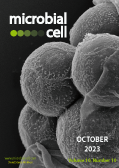Table of contents
Volume 10, Issue 10, pp. 204 - 232, October 2023
Cover: SEM microscopic image Sphaeroforma arctica, a unicellular with a central role in the tree of life. First isolated isolated from the arctic marine amphipod Gammarus setosus, Sphaeroforma arctica are spherical cells with the capacity to grow into multi-nucleated coenocytes (image by Multicellgenome Lab, University Pompeu Fabra, Spain; image retreived from Flickr and modified by MIC). The cover is published under the Creative Commons Attribution (CC BY) license.
Enlarge issue cover
Phospholipases A and Lysophospholipases in protozoan parasites
Perrine Hervé, Sarah Monic, Frédéric Bringaud and Loïc Rivière
Reviews |
page 204-216 | 10.15698/mic2023.10.805 | Full text | PDF |
Abstract
Phospholipases (PLs) and Lysophospholipases (LysoPLs) are a diverse group of esterases responsible for phos-pholipid or lysophospholipid hydrolysis. They are involved in several biological processes, including lipid catabolism, modulation of the immune response and membrane maintenance. PLs are classified depending on their site of hydrolysis as PLA1, PLA2, PLC and PLD. In many pathogenic microorganisms, from bacteria to fungi, PLAs and LysoPLs have been described as critical virulence and/or pathogenicity factors. In protozoan parasites, a group containing major human and animal pathogens, growing literature show that PLAs and LysoPLs are also involved in the host infection. Their ubiquitous presence and role in host-pathogen interactions make them particularly interesting to study. In this review, we summarize the literature on PLAs and LysoPLs in several protozoan parasites of medical relevance, and discuss the growing interest for them as potential drug and vaccine targets.
Investigation of the acetic acid stress response in Saccharomyces cerevisiae with mutated H3 residues
Nitu Saha, Swati Swagatika and Raghuvir Singh Tomar
Research Articles |
page 217-232 | 10.15698/mic2023.10.806 | Full text | PDF |
Abstract
Enhanced levels of acetic acid reduce the activity of yeast strains employed for industrial fermentation-based applications. Therefore, unraveling the genetic factors underlying the regulation of the tolerance and sensitivity of yeast towards acetic acid is imperative for optimising various industrial processes. In this communication, we have attempted to decipher the acetic acid stress response of the previously reported acetic acid-sensitive histone mutants. Revalidation using spot-test assays and growth curves revealed that five of these mutants, viz., H3K18Q, H3S28A, H3K42Q, H3Q68A, and H3F104A, are most sensitive towards the tested acetic acid concentrations. These mutants demonstrated enhanced acetic acid stress response as evidenced by the increased expression levels of AIF1, reactive oxygen species (ROS) generation, chromatin fragmentation, and aggregated actin cytoskeleton. Additionally, the mutants exhibited active cell wall damage response upon acetic acid treatment, as demonstrated by increased Slt2-phosphorylation and expression of cell wall integrity genes. Interestingly, the mutants demonstrated increased sensitivity to cell wall stress-causing agents. Finally, screening of histone H3 N-terminal tail truncation mutants revealed that the tail truncations exhibit general sensitivity to acetic acid stress. Some of these N-terminal tail truncation mutants viz., H3 [del 1-24], H3 [del 1-28], H3 [del 9-24], and H3 [del 25-36] are also sensitive to cell wall stress agents such as Congo red and caffeine suggesting that their enhanced acetic acid sensitivity may be due to cell wall stress induced by acetic acid.










